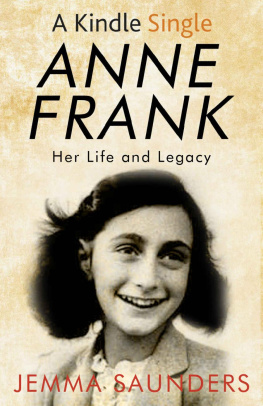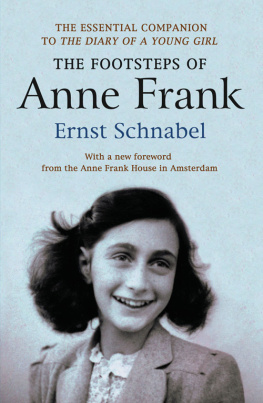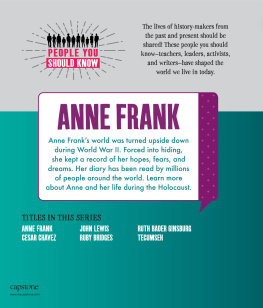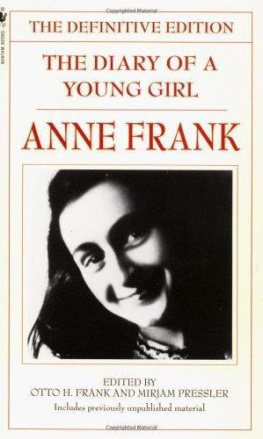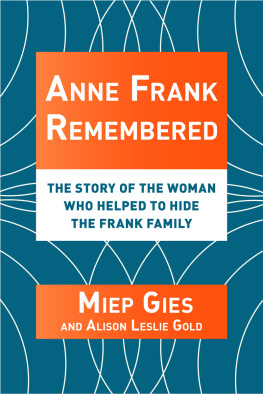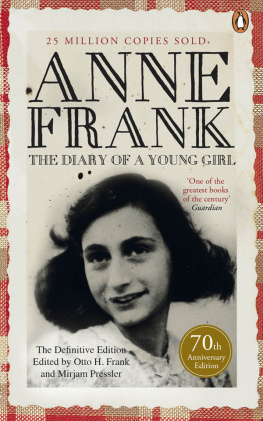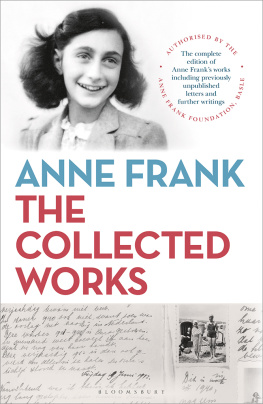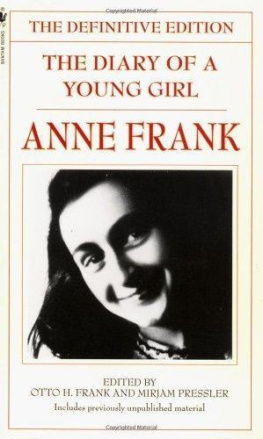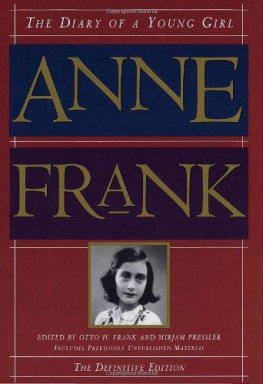Anne Frank: Life, Diary, Legacy
Jemma Saunders
Copyright Jemma J. Saunders 2015
The right of Jemma J. Saunders to be identified as the author of this work has been asserted by her in accordance with the Copyright, Designs and Patents Act, 1988.
First published in 2015 by Endeavour Press Ltd.
Table of Contents
Introduction
Anne Frank is arguably the most well-known victim of the Holocaust, the 20th century genocide in which some six million Jews were systematically murdered in Europe under the Nazi regime. Born into a well-to-do, liberal Jewish family in Germany at the end of the 1920s, almost the entire course of her life was determined by the rise of the Nazi party: from the day her family fled Germany to build a new life in Amsterdam in 1933; to the twenty-five months they spent hiding in the back of a warehouse before the tragedy of their betrayal and deportation. Anne was just 15 years old when she perished in Bergen-Belsen concentration camp in 1945.
The teenage Anne started keeping a diary shortly before the Frank family went into hiding in 1942, and over the course of two years she honed her craft as a writer, documenting the details of their daily lives alongside her personal reflections, fears, and aspirations. By chance, the majority of her writings were saved after the family was arrested and in 1947, after much deliberation, her father oversaw the publication of the first edition of her diary in the Netherlands. Within a decade, it had become an international bestseller. First adapted for both stage and screen in the 1950s, awareness and readership of Annes diary continued to grow and its author became a household name, gradually acquiring something of a symbolic status.
In the intervening years, the diary has had its share of critics as well as champions, and to this day there are those who refute that the historical events that surround its writing and publication ever took place. Nevertheless, in the 21st Century, The Diary of a Young Girl remains one of the most widely read non-fiction books in the world and Anne Franks story, whether portrayed in writing, film or on the stage, continues to evoke curiosity and emotion.
Part One: Frankfurt and Amsterdam
A German Family
Annelies Marie Frank was born on 12 June 1929 in the German city of Frankfurt-am-Main. She was the second daughter of Otto Frank and Edith Hollnder, who had married in Aachen on 12 May 1925. An older sister, Margot Betti, had been born on 16 February 1926.
Otto Frank celebrated his 36th birthday the day he married Edith Hollnder, who was almost eleven years his junior. It is not clear how the couple met, but it is probable that the marriage was a matter of practicality as well as love, since Edith had a considerable dowry. Both came from assimilated German Jewish families, although Edith maintained a stronger connection to Judaism than her husband, who seldom attended synagogue, had not had a Bar Mitzvah and had never learned Hebrew. Edith, on the other hand, had grown up in a kosher household in the northern city of Aachen and continued to attend synagogue when she moved with Otto to Frankfurt, where his family owned a small but prosperous bank.
Both Otto and Edith could trace their families roots in Germany back generations; in Ottos case beyond the 1700s. He was the second of four children, three brothers and a sister born in the last decades of the 19th century. Edith had two surviving older brothers, Julius and Walter, and was from a reasonably wealthy industrial family, prominent among Aachens Jewish community. Her sister Bettina had died of appendicitis when Edith was just 14, and twelve years later Edith later chose Margots middle name, Betti, in memory of her.
As a young man Otto studied economics for a year at Heidelberg University, but he decided not to continue his studies and instead travelled to New York, where he worked in Macys department store. His American adventure was cut short, however, by the unexpected death of his father Michael in September 1909, though he did later return to the USA and maintained a lifelong friendship with the son of Macys owner. When World War One broke out, Otto became one of 100,000 Jews to serve in the Germany Army during the conflict, rising to the rank of lieutenant. His future brother-in-law Julius Hollnder also fought in the war and both families considered themselves German first and foremost. In the years following the armistice, Otto took more responsibility in the family business, attempting to open a branch of the bank in Amsterdam in 1923. This venture proved unsuccessful and he returned to Frankfurt, though his connection with Amsterdam would prove important a decade later.
After his marriage to Edith and their honeymoon in Italy, Otto returned to work in the bank. The newlywed couple boarded with his mother, Alice Frank, in the large family home on Mertonstrasse until 1927, when they moved with baby Margot to an apartment of their own on Marbachweg. This was where their second daughter Annelies was brought home, twelve days after her hospital birth.
Anne, as she later became known, was something of a difficult child. Unlike her sister Margot, who had been a peaceful baby and a similarly demure toddler, Annes infancy was characterised by sleepless nights and bouts of colic. Margot was nevertheless delighted to have a new sibling and often took Anne out for walks in her pram. Edith was a devoted mother and enjoyed domestic help in the family home from a young woman named Kathi Stilgenbauer. Perhaps unusually for a father of the era, Otto was just as involved in his daughters upbringings as Edith. They affectionately called him Pim and from an early age he incorporated education into their childhood, creating stories about two characters called Good Paula and Bad Paula as a means of teaching Margot and Anne about right and wrong.
The wider family circle remained in close contact and both Anne and Margot enjoyed the affections of their other relatives. Both their widowed grandmothers visited the Franks often, especially when they no longer lived with Ottos mother. While Alice was called Omi by her grandchildren, Ediths mother, Rosa Hollnder, was referred to as Oma. Inquisitive and outspoken from an early age, as a toddler Anne once loudly asked commuters on a tram if any of them would offer a seat to her elderly grandmother.
The children also enjoyed visits from Ediths brothers, Julius and Walter, who had no children of their own but adored their nieces. Among Ottos siblings, only his sister Leni and her husband Erich Elias had children; two boys called Stephan and Bernhard, who was usually known as Buddy but whom Anne called Bernd. Stephan was born in 1921 and Buddy in 1925. Although closest in age to Margot, Buddy would later reflect more on his connection to Anne, with whom he shared a mischievous kinship.
The Franks, Hollnders and Eliases marked Jewish festivals throughout the year and although Anne and Margot were not brought up in an orthodox Jewish home, they were by no means unaware of their familys religious heritage. At the time of Annes birth, all her immediate family lived in Germany. Within a decade, economic and political circumstance would see them scattered across five countries and two continents.
The Nazi Shadow
Around four months after Anne was born, in October 1929, the Wall Street stock market crashed in America, prompting the worldwide depression of the 1930s. For a family like the Franks, whose livelihood centred on banking, the Wall Street Crash was no small impediment to their wellbeing. Indeed, the impact across Germany as a whole was keenly felt. Businesses were once again in the midst of financial crisis, having barely recovered from the economic turmoil that had followed the end of World War One. Erich Elias, recognising a more promising opportunity, moved to Switzerland in late 1929 and began making arrangements for Leni and his boys to join him over the next couple of years.
Next page
